Bulbs
Flower Basics
Flower Beds & Specialty Gardens
Flower Garden
Garden Furniture
Garden Gnomes
Garden Seeds
Garden Sheds
Garden Statues
Garden Tools & Supplies
Gardening Basics
Green & Organic
Groundcovers & Vines
Growing Annuals
Growing Basil
Growing Beans
Growing Berries
Growing Blueberries
Growing Cactus
Growing Corn
Growing Cotton
Growing Edibles
Growing Flowers
Growing Garlic
Growing Grapes
Growing Grass
Growing Herbs
Growing Jasmine
Growing Mint
Growing Mushrooms
Orchids
Growing Peanuts
Growing Perennials
Growing Plants
Growing Rosemary
Growing Roses
Growing Strawberries
Growing Sunflowers
Growing Thyme
Growing Tomatoes
Growing Tulips
Growing Vegetables
Herb Basics
Herb Garden
Indoor Growing
Landscaping Basics
Landscaping Patios
Landscaping Plants
Landscaping Shrubs
Landscaping Trees
Landscaping Walks & Pathways
Lawn Basics
Lawn Maintenance
Lawn Mowers
Lawn Ornaments
Lawn Planting
Lawn Tools
Outdoor Growing
Overall Landscape Planning
Pests, Weeds & Problems
Plant Basics
Rock Garden
Rose Garden
Shrubs
Soil
Specialty Gardens
Trees
Vegetable Garden
Yard Maintenance
How to Install a Sand Fence
How to Install a Sand Fence. Sand fences, like snow fences, act as windbreaks and slow the speed of blowing particles, in this case bits of blowing sand. When the wind blows over the fence, an eddy forms behind it, causing a dune to form on the windward side of the fence. Such fences are used to form dunes where they are wanted or to prevent sand...
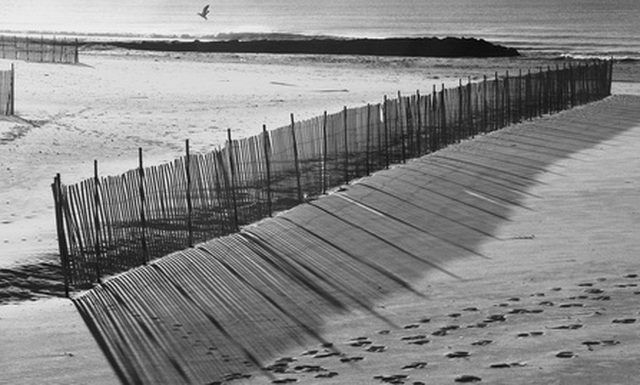
Sand fences, like snow fences, act as windbreaks and slow the speed of blowing particles, in this case bits of blowing sand. When the wind blows over the fence, an eddy forms behind it, causing a dune to form on the windward side of the fence. Such fences are used to form dunes where they are wanted or to prevent sand from being blown where it is not wanted. Sand fencing can be an effective tool to restore and stabilize dune formation along shorelines. Sand fences also can be used in desert settings to prevent erosion and to minimize sand drift on to roads.
Things You'll Need
Fencing material, wooden slat or plastic mesh
Steel studded T or U fence posts
Post hole digger
Hammer
Measuring tape
2 boards for every fence post, 6 feet long by 2-by-2-inches (when using plastic fencing)
Wire fence ties
Support wire
Pliers
Wire cutters
Location
Contact your state's Department of Natural Resources to determine whether or not there are guidelines or regulations governing the installation of sand fences in your area if you want to install a sand fence on a coastline.
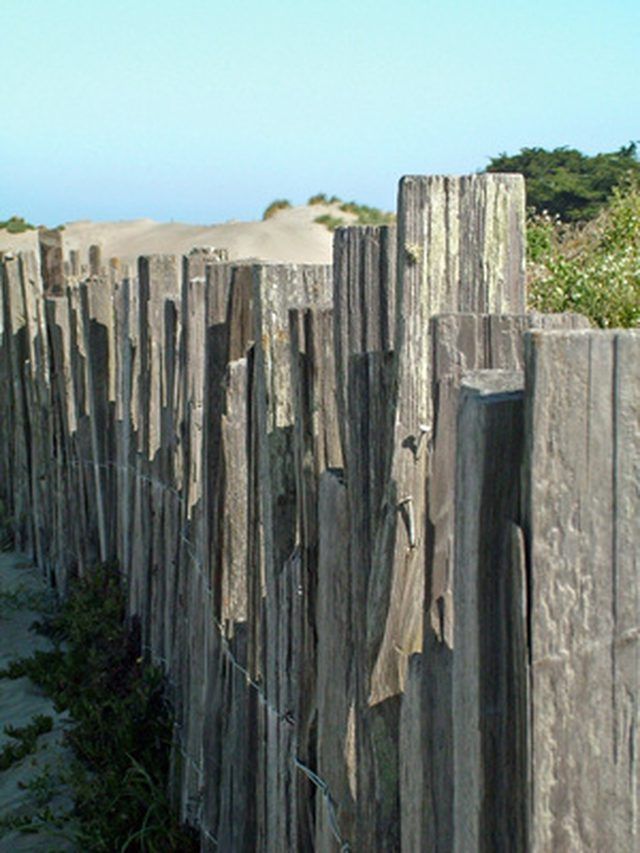
Find the crest of the primary or frontal dune. If you will install the fence parallel to a shoreline, choose a line on the land side and not the water side of this primary dune.
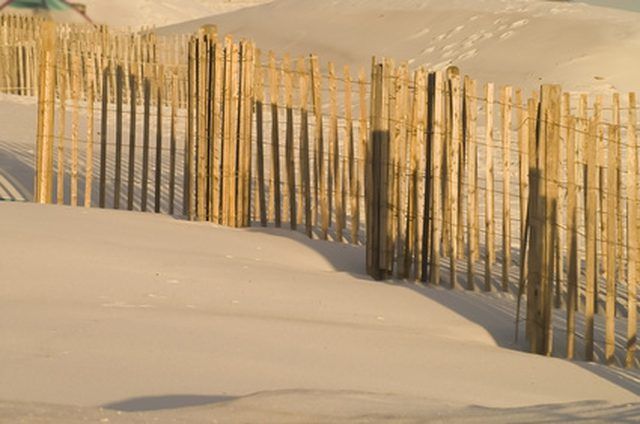
Do not install the fence on a wet sand beach. It will be vulnerable to waves.
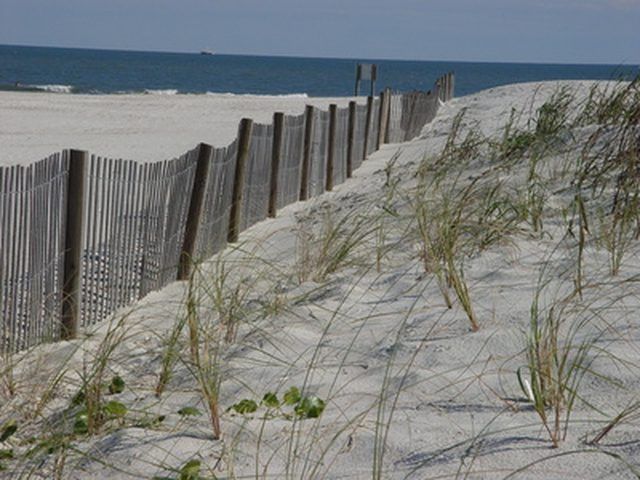
Roll out the fence material, whether wood slat or plastic mesh, the length of the site where you plan to install it.
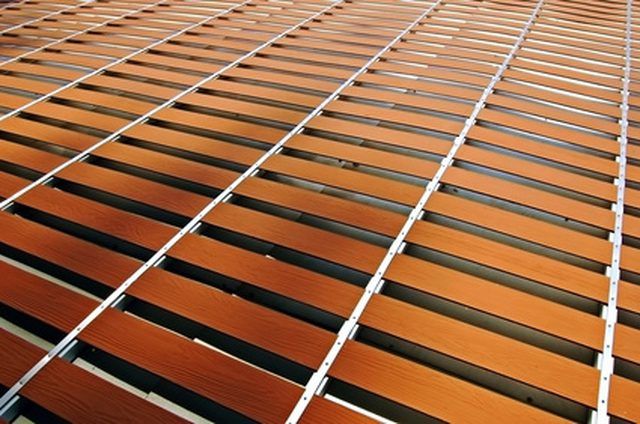
Installation
Soak with water the specific sites where you dig the fence post holes. This will help prevent the soft sand from falling back into the hole as you dig. Fence posts should be 8 feet apart, except for the two end posts, which should be 6 feet from the post nearest them.
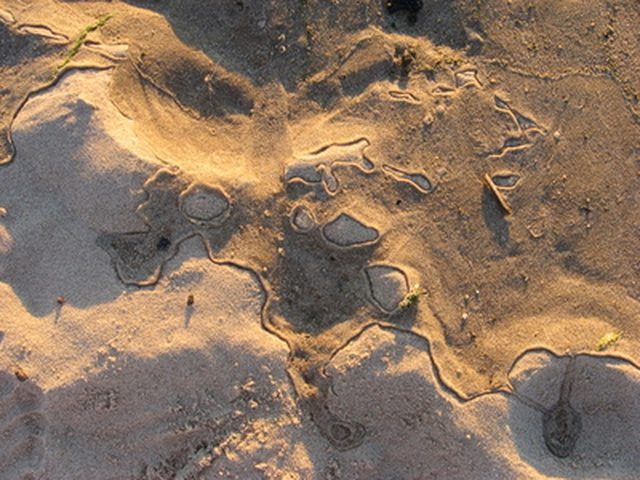
Dig holes for the fence posts. For a 4 foot fence, plan to leave about 4-1/2 feet of the post above the sand, as a small gap will be left between the bottom of the fence and the surface of the sand.
Place a fence post into each hole and hammer it in to secure the post before shoveling sand back into the hole. Tamp down the sand around each post before moving on to work on the next post. Again, the posts should be 8 feet apart, except for the end posts, which should be 6 feet from the nearest post.
Attach the top of the fence to the top of the posts, starting at one end and working toward the other end. Tie the fence in place with a wire fence tie.
Pull wood slat fences taut to at least 250 pounds per foot. Synthetic fence material should be pulled taut to manufacturer specifications.
Leave a gap of 4 to 8 inches between the bottom of the fence and the top of the sand's surface.
Secure the bottom of the fence to each post with wire fence ties. Secure the middle of the end posts also with fence ties. Use wire for additional strength, as needed.
For synthetic fences, sandwich two 2-by-2-inch, 6-foot-long wood boards around the metal fence posts, burying the excess length of the wood beneath the sand's surface. Wire the wood securely into place at each end of the metal post and again in the middle.
Tips & Warnings
Check with your Department of Natural Resources for rules and regulations governing sand fence placement in your state, particularly in coastal areas.
Install sand fences in spring or early summer and plant beach grass in the fall around the fence to help stabilize dune formation.
Avoid installing long lengths of sand fence along public access shorelines.